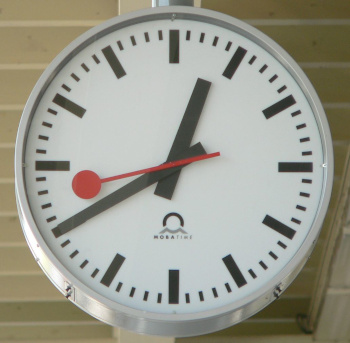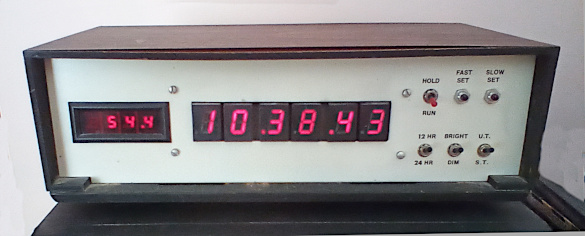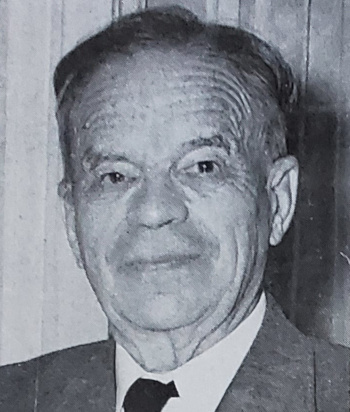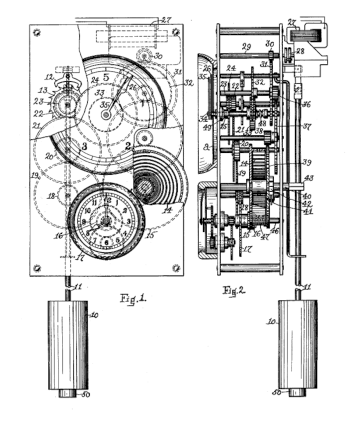60 Hertz Standard
May 27, 2024
Extremely
precise timekeeping is now ubiquitous as a consequence of precision
quartz crystal and
surface acoustic wave oscillators in
cellphones and
computers. These are
synchronized by
signals on the
Internet. In the
mid-20th century, several crude
technologies were employed for accurate timekeeping, one of which was synchronization with
transmitted data from
shortwave radio stations. In
North America, these were the
National Institute of Standards and Technology (NIST; formerly, the National Bureau of Standards, NBS) time station,
WWV, and the
Canadian National Research Council time station,
CHU.
A
television station at which I
worked one
summer during my
undergraduate college days had a precision
pendulum clock that synchronized all clocks in the station. The pendulum clock itself was
manually synchronized to the
television network daily/a>. One radio station at which I worked had a clock synchronized by the
Western Union time service using a signal transmitted over
telephone wires.

A very expensive clock face design, as illustrated by a clock in the main railway station in Zürich, Switzerland.
In September, 2012, Apple paid Swiss Federal Railways (SBB) an undisclosed sum to settle a copyright lawsuit over its use of the SBB iconic clock face in its IOS 6 clock application.[1]
The clock face was designed in 1944 by Hans Hilfiker (1901-1993).
(Wikimedia Commons image by Jürgen Götzke . Click for larger image.)
About fifty years ago, I designed and built a
digital clock (see figure). At that time, digital clocks were
rare; and, rarer still were ones that showed
seconds as well as
hours and
minutes. The
time base for this clock was derived from the 60
hertz utility frequency of
electrical power in the
United States. The clock was very
accurate, since this frequency is closely maintained, principally for the purpose of sharing power across members of the
North American power transmission grid. For this purpose,
phase as well as frequency must be synchronized.

My digital clock with seconds indication, constructed in 1975 and still operational. The temperature indicator, showing 54.4 °F at the time of this photo, was added at a later date. It's connected by wire to a temperature sensor at my front porch. Today, it's very easy to build a device that uses WiFi to extract both an accurate time and local temperature from Internet websites. (Photo by the author. Click for larger image.)
In 1897, at the start of the
electrical age, utility frequencies in North America ranged from 25 Hz to 140 Hz. Various incidental factors caused a
convergence on 60 Hz in the United States, while other countries selected 50 Hz.[2] As explained in a 1997
paper by Edward I. Owen,[2]
"The choice was between 50- and 60-Hz, and both were equally suited to the needs. When all factors were considered, there was no compelling reason to select either frequency. Finally, the decision was made to standardize on 60-Hz as it was felt to be less likely to produce annoying light flicker."
Henry E. Warren (1872-1957), an 1894
electrical engineering graduate of the
Massachusetts Institute of Technology (MIT, Cambridge, Massachusetts), installed an
electric clock at the
Boston L Street generating station of the
Edison Illuminating Company to maintain the frequency of its
alternating current (AC) generator at 60 Hz.[3] Warren's
proclivity for
invention was apparent early in his
career, since he was
co-inventor with MIT
classmate,
George C. Whipple (1866-1924), of an 1895
patent for an electric thermometer.[4] His synchronizing clock was further proof that
Thomas Alva Edison (1847-1931), who had advocated
direct current (DC) electrical power distribution, had lost the
war of the currents. Warren's clock used a
self-starting synchronous motor, the first of its kind, and a
pendulum.[3]

Henry E. Warren (1872-1957).
Warren, who is credited with 134 inventions, was founder of the Warren Telechron Company, fully acquired by General Electric in 1943.
Telechron went out of business in 1992 after selling millions of household electric clocks.
Warren is credited as inventor of a clock that used a vibrating metal wire instead of a pendulum, but I was unable to find any patent for this.
Wikimedia Commons image by Neonedge, from the Lombard Governor Company Brochure. "Lombard's Second 50 years in Ashland."
After graduation from MIT, Warren started his engineering career in
Michigan, finally returning to Boston in 1902, starting a
machine shop, and founding the Warren Gear Works.[3] In 1912, he founded the Warren Clock Company to make
battery powered pendulum clocks.[3] These were not very good timekeepers, and Warren decided to focus his interest on fully electric clocks.[3] The result was his invention of the synchronous motor, an AC motor that
rotates at the same frequency as its power source. However, a clock based on such a motor would only be as accurate as the frequency of its power source; thus his goal of getting electrical generators, such as that of the L Street station, to maintain an accurate frequency.[3]
Warren's October 23, 1912, installation of his synchronizing clock at the L Street station marked the start of the Warren Clock Company, where he began
production of his Type A master station clock.[3] This device had two
hands on a single
clock face, and the frequency regulation was
manual - The generator
operator monitored the two hands to determine whether his electric generator was
spinning too fast or too slow.[3] His company's final model, the Type E, was introduced in 1929.[3] By the end of the 1940s, Warren Telechron Company clocks were used to regulate the power frequency of more than 90% of U.S.
power transmission lines.[3] In 1937, Warren
estimated that electric clock usage by electricity
customers would easily
defray the cost of his frequency regulating clocks.[3]
In its early days, the Warren Telechron Company had a large
market share for home electric clocks, but the advent of quartz timekeeping in the
1950s and the later introduction of digital clocks vastly eroded its
profitability.[3] General Electric had bought a 49% interest in the Warren Clock Company in 1917, and it fully absorbed the company in 1943 into its Clock and Timer Division after Warren's
retirement.[3] Warren was awarded the
IEEE Lamme Medal in 1935 by the
American Institute of Electrical Engineers, now the
Institute of Electrical and Electronics Engineers (IEEE), for "outstanding contributions to the development of electrical clocks and means of controlling central station frequencies."[3]

An example of one of Henry E. Warren's early patents.
Shown are figures one and two from his US Patent No. 1,502,493, "Time-indicating apparatus," issued July 22, 1924.[5]
The first claim of this patent reads, "In an instrument of the character described, a standard clock, a synchronous motor, two hands mounted concentrically, connections between one hand and the standard clock and between the other hand and the synchronous motor, so proportioned that both hands revolves normally at the same rate, and connections between the synchronous motor and the driving mechanism of the standard clock whereby the spring of the latter is kept constantly wound."
(Click for larger image.)
References:
- Iain Thomson, "Apple pays up for stealing design from Swiss Railways," The Register, October 12, 2012.
- Edward 1. Owen, "The origins of 60-Hz as a power frequency," IEEE Industry Applications Magazine, November/December 1997.
- Allison Marsh, "This Clock Made Power Grids Possible," IEEE Spectrum, February 29, 2024.
- G. C. Whipple And H. E. Warren, Electrical thermometer, US Patent No. 540,008, May 28, 1895 (via Google Patents).
- H. E. Warren, "Time-indicating apparatus," US Patent No. 1,502,493, July 22, 1924
Linked Keywords: Accuracy and precision; precise; timekeeping; quartz crystal; surface acoustic wave; electronic oscillator; mobile phone; cellphone; computer; synchronization; synchronize; signal; Internet; mid-20th century; technology; technologies; transmission (telecommunications); transmitted; data; shortwave radio station; North America; National Institute of Standards and Technology (NIST; formerly, the National Bureau of Standards, NBS); WWV (radio station); Canada; Canadian; National Research Council; CHU (radio station); television station; employment; work; summer; undergraduate education; undergraduate college days; pendulum clock; manual labour; manual; television network; day; daily; radio broadcasting; radio station; Western Union; dry loop; telephone wire; Clock in the main railway station in Zürich, Switzerland; cost; expensive; clock face; design; train station; railway station; Zürich, Switzerland; Apple Inc.; Swiss Federal Railways (SBB); copyright; lawsuit; Swiss railway clock; iconic clock face; IOS 6; application software; Hans Hilfiker (1901-1993); Wikimedia Commons; Jürgen Götzke; digital clock; rarity; rare; second; hour; minute; time base; hertz; utility frequency; electrical grid; electrical power; United States; accurate; North American power transmission grid; phase (waves); digital clock with seconds indication, constructed in 1975; temperature; thermometer; indicator; Fahrenheit; °F; photograph; photo; wire; temperature sensor; front porch; WiFi; data scraping; extract; time; Internet; website; electricity generation; electrical age; technological convergence; academic publishing; paper; annoyance; annoying; flicker (light); light flicker; Henry E. Warren (1872-1957); electrical engineering; graduation; graduate; Massachusetts Institute of Technology (MIT, Cambridge, Massachusetts); electric clock; Boston; Edison Illuminating Company; alternating current (AC); electric generator; proclivity; invention; career; co-inventor; classmate; George C. Whipple (1866-1924); patent; Thomas Alva Edison (1847-1931); direct current (DC); war of the currents; self-starting synchronous motor; pendulum; organizational founder; Warren Telechron Company; acquisition; acquired; General Electric; business; household; acoustics; vibrating; metal; wire; Michigan; machine shop; battery (electricity); rotation; rotate; manufacturing; production; clock hands; clock face; manual labour; manual; operator (profession); monitor; monitored; rotation around a fixed axis; spin; power transmission line; approximation; estimate; customer; defray; market share; 1950s; profit (accounting); profitability; retirement; IEEE Lamme Medal; American Institute of Electrical Engineers; Institute of Electrical and Electronics Engineers (IEEE); H. E. Warren, 'Time-indicating apparatus,' US Patent No. 1,502,493, July 22, 1924; claim; measuring instrument; standard (metrology); concentric; concentrically; proportionality (mathematics); proportioned; rotation; revolve; rate (mathematics); mechanism (engineering); spring (device); mainspring; constantly wound.